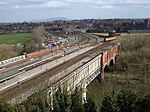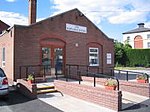Shrewsbury Abbey railway station

Shrewsbury Abbey was a railway station in Shrewsbury, Shropshire, England part of the Shropshire and Montgomeryshire Railway. It was named after the nearby Shrewsbury Abbey. The station had an adjacent goods yard and wagon building works. Shrewsbury Abbey was originally planned to be just one station on a railway from Llanymynech to Market Drayton but when financial problems halted the project, it became the permanent terminus. However it was never connected to Shrewsbury Station. All passenger services would have to change here. This was because access to the mainline station was rejected on financial grounds and the obstruction of Shrewsbury station's joint operators, the Great Western Railway (GWR) and the London and North Western Railway.
Excerpt from the Wikipedia article Shrewsbury Abbey railway station (License: CC BY-SA 3.0, Authors, Images).Shrewsbury Abbey railway station
Old Potts Way,
Geographical coordinates (GPS) Address Nearby Places Show on map
Geographical coordinates (GPS)
| Latitude | Longitude |
|---|---|
| N 52.7069 ° | E -2.7435 ° |
Address
Abbey Foregate
Old Potts Way
SY3 7BP , Coleham
England, United Kingdom
Open on Google Maps










